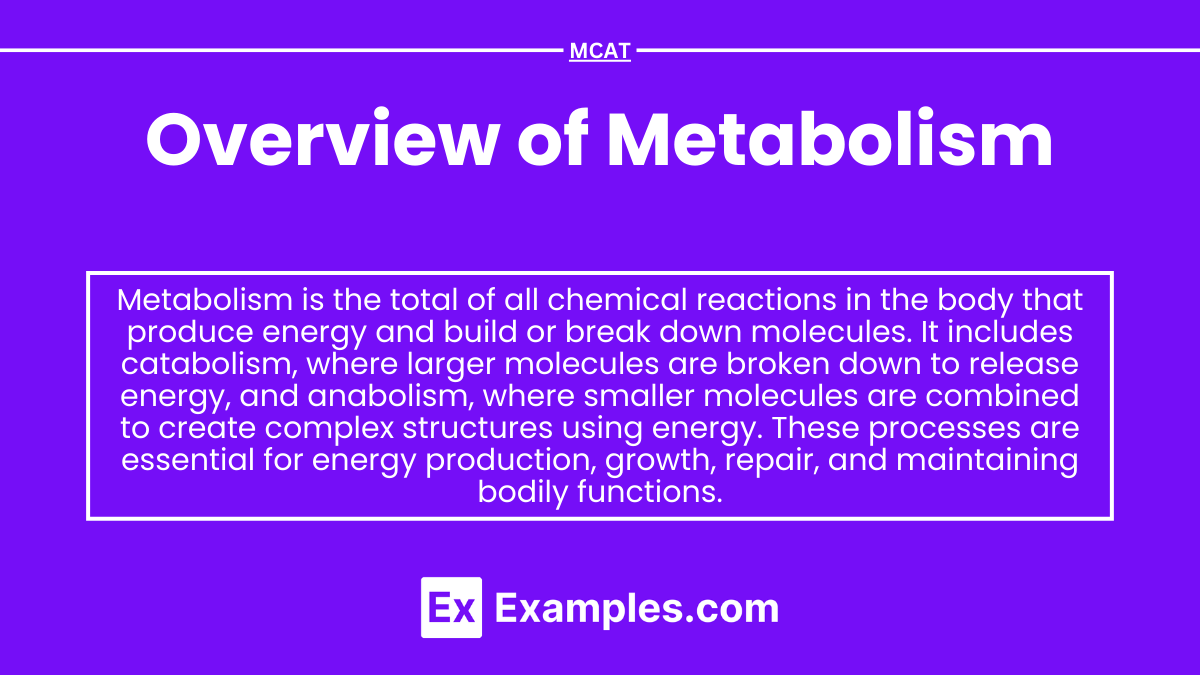Preparing for the MCAT requires a solid understanding of metabolism, a foundational topic in biochemistry. This subject covers the chemical reactions that convert nutrients into energy and essential compounds, focusing on processes like glycolysis, the Krebs cycle, and oxidative phosphorylation. It also includes energy balance, enzyme action, and the regulation of anabolic (building up) and catabolic (breaking down) pathways. Mastering metabolism is vital for grasping concepts related to energy production, nutrient utilization, and cellular function, making it essential for achieving a high score on the MCAT.
Learning Objectives
When studying the Overview of Metabolism for the MCAT, focus on understanding the key metabolic pathways, including glycolysis, the Krebs cycle, and oxidative phosphorylation, as well as how they convert nutrients into ATP, the primary energy currency. Learn to differentiate between anabolic and catabolic processes, recognizing how they either consume or release energy for growth, repair, and energy production. Gain a clear grasp of how ATP is produced, used, and transferred within cells, with emphasis on the roles of NADH and FADH₂ as electron carriers. Additionally, explore how enzymes regulate these metabolic reactions, controlling the direction, rate, and efficiency of pathways, as well as how they respond to cellular needs through mechanisms like feedback inhibition. Mastering these concepts is crucial for understanding energy dynamics, nutrient utilization, and cellular function, all of which are essential for achieving a high score on the MCAT.
Key Components of Metabolism
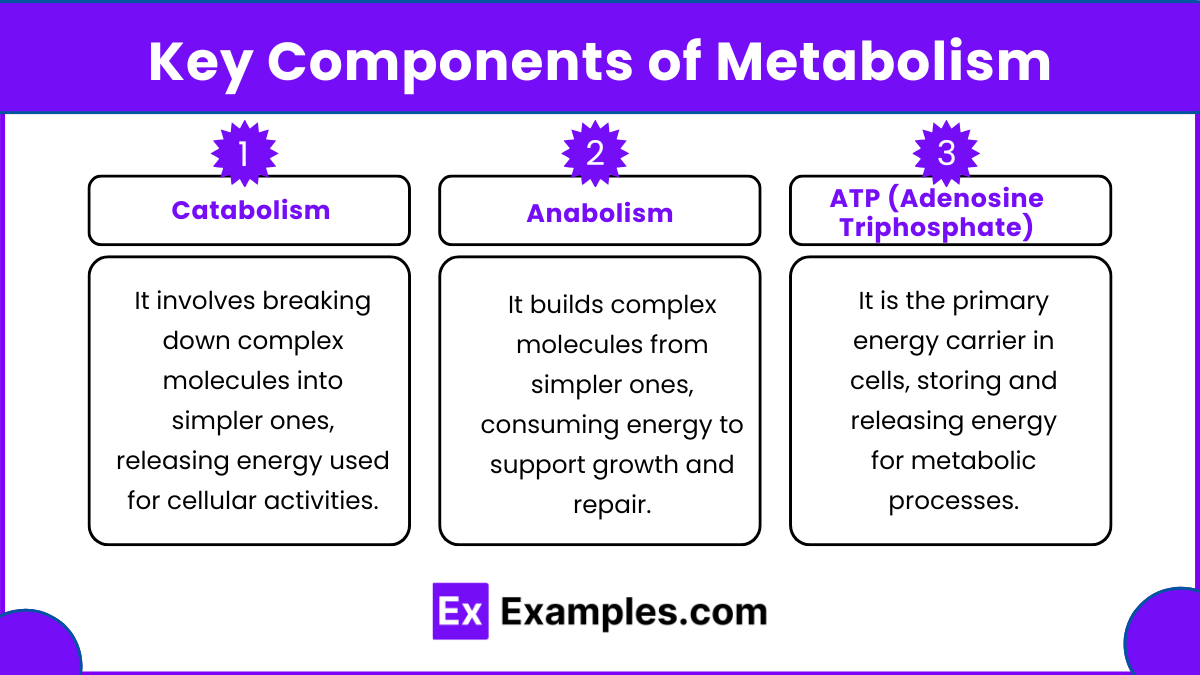
- Catabolism
- The breakdown of complex molecules (e.g., carbohydrates, proteins, and fats).
- Releases energy in the form of ATP and heat.
- Examples include glycolysis, beta-oxidation, and the citric acid cycle.
- Anabolism
- The synthesis of complex molecules from simpler ones.
- Consumes energy (ATP) for processes like protein synthesis, DNA replication, and lipid synthesis.
- ATP (Adenosine Triphosphate)
- Acts as the primary energy currency of the cell.
- Energy is stored in the high-energy phosphate bonds.
- ATP is produced via processes like glycolysis, citric acid cycle, and oxidative phosphorylation.
Major Metabolic Pathways
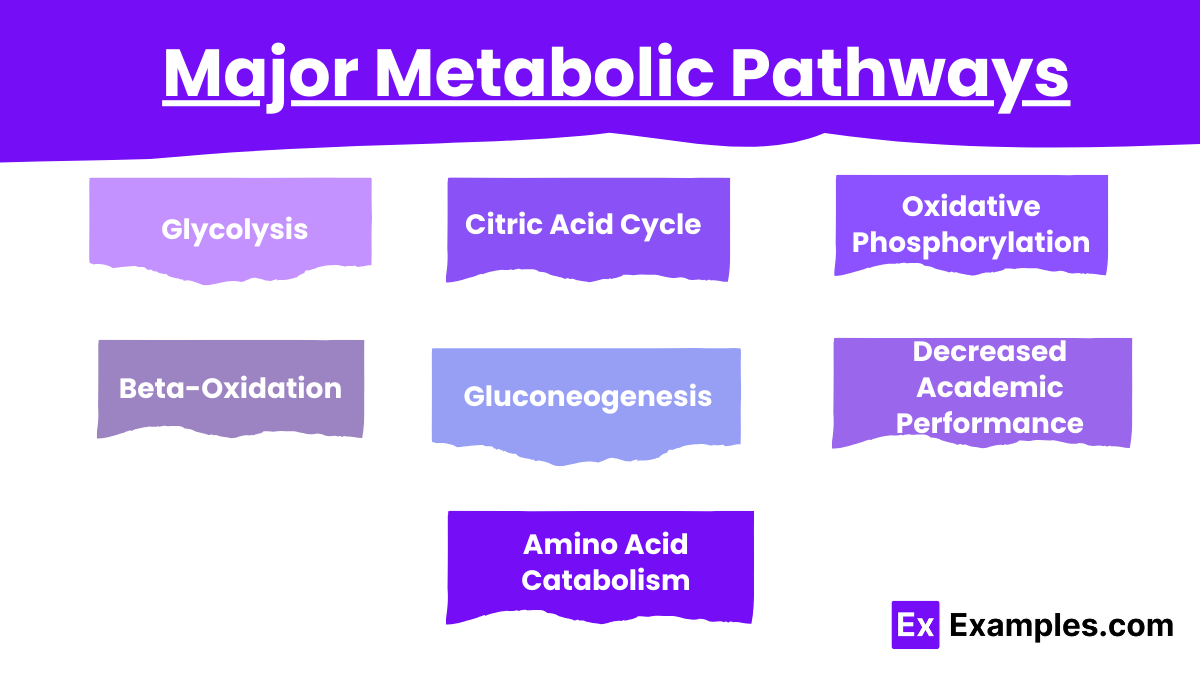
- Glycolysis
- Location: Cytoplasm.
- Converts glucose (6 carbons) into 2 pyruvate molecules (3 carbons each).
- Net production of 2 ATP and 2 NADH.
- Does not require oxygen (anaerobic pathway).
- Citric Acid Cycle (Krebs Cycle)
- Location: Mitochondrial matrix.
- Begins with acetyl-CoA combining with oxaloacetate to form citrate.
- Produces 2 CO₂, 3 NADH, 1 FADH₂, and 1 GTP per acetyl-CoA.
- Central pathway for energy production, connected to both catabolic and anabolic processes.
- Oxidative Phosphorylation
- Location: Inner mitochondrial membrane.
- Involves the electron transport chain and chemiosmosis.
- NADH and FADH₂ donate electrons, leading to ATP production.
- Oxygen is the final electron acceptor, forming water.
- Beta-Oxidation
- Breakdown of fatty acids to produce acetyl-CoA.
- Occurs in the mitochondria.
- Generates NADH and FADH₂ for ATP production via oxidative phosphorylation.
- Gluconeogenesis
- The synthesis of glucose from non-carbohydrate sources like amino acids and glycerol.
- Primarily occurs in the liver and kidney during fasting states.
- Requires energy, with ATP and GTP consumption.
- Pentose Phosphate Pathway (PPP)
- Generates NADPH and ribose-5-phosphate.
- NADPH is essential for fatty acid synthesis and oxidative stress management.
- Ribose-5-phosphate is crucial for nucleotide synthesis.
Regulation of Metabolism
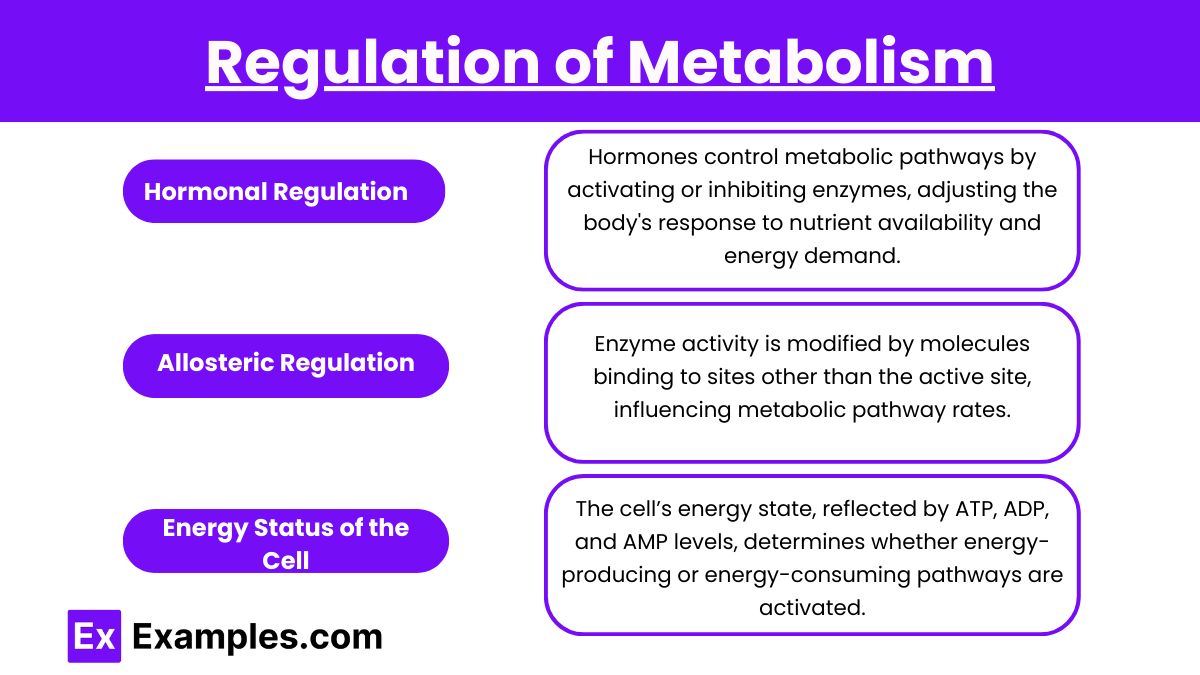
- Hormonal Regulation
- Insulin: Promotes anabolic pathways (e.g., glycogenesis, lipogenesis).
- Glucagon: Promotes catabolic pathways (e.g., glycogenolysis, gluconeogenesis).
- Epinephrine: Activates glycogen breakdown during stress.
- Cortisol: Enhances gluconeogenesis and lipolysis.
- Allosteric Regulation
- Key enzymes are regulated by substrates, products, or intermediates of the pathway.
- For example, phosphofructokinase-1 (PFK-1) in glycolysis is inhibited by high levels of ATP.
- Energy Status of the Cell
- High ATP levels inhibit catabolic pathways, while low ATP levels activate them.
- AMP and ADP act as indicators of low energy status, activating catabolic pathways.
Importance of Metabolism
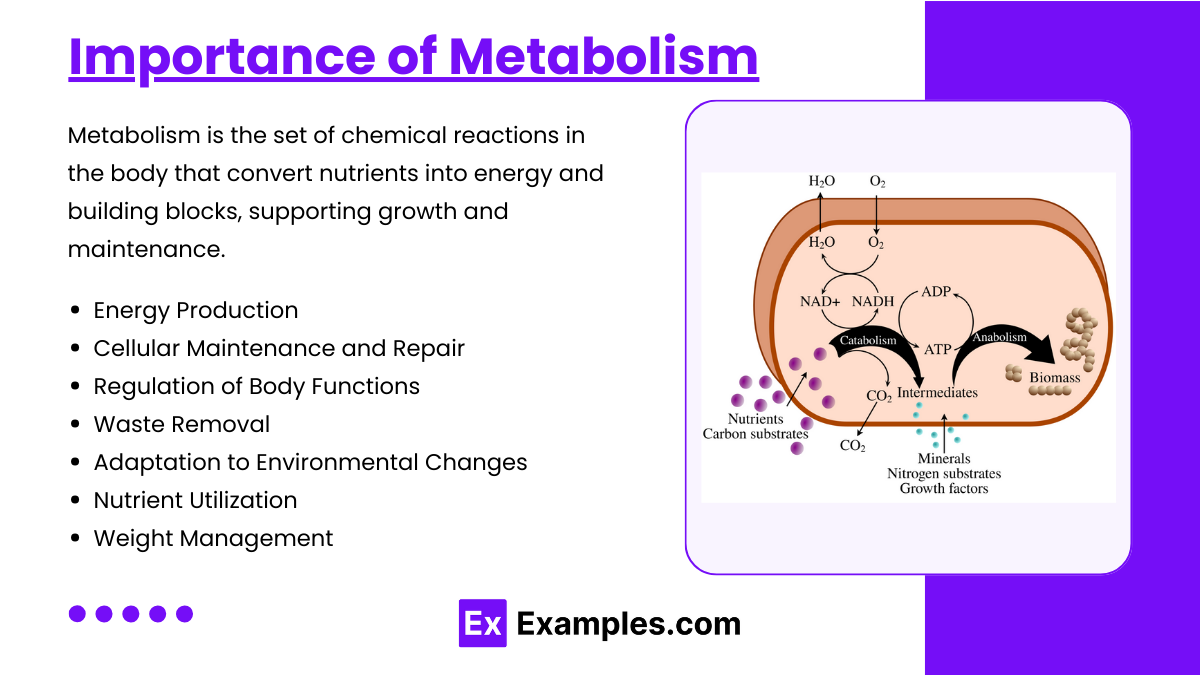
- Energy Production
- Metabolism is responsible for converting nutrients into usable energy (ATP).
- This energy fuels all cellular activities, from muscle contraction to nerve impulses, enabling the body to perform daily functions and maintain homeostasis.
- Cellular Maintenance and Repair
- Metabolism helps in the synthesis of new proteins, nucleic acids, and lipids needed for cell growth, maintenance, and repair.
- Anabolic processes build and maintain cellular structures, ensuring proper function and regeneration of tissues.
- Regulation of Body Functions
- Hormones like insulin, glucagon, thyroid hormones, and cortisol regulate metabolic processes, impacting blood sugar levels, fat storage, and energy expenditure.
- Proper metabolic function maintains vital signs like temperature, heart rate, and breathing rate.
- Waste Removal
- Catabolic processes break down complex molecules into simpler ones, leading to the elimination of waste products.
- Effective metabolism ensures the detoxification of harmful substances, maintaining a healthy internal environment.
- Adaptation to Environmental Changes
- Metabolism adjusts based on food intake, fasting, exercise, or stress, allowing the body to adapt to changing conditions.
- For example, during fasting, metabolism switches to using stored energy (glycogen and fats) to sustain bodily functions.
- Nutrient Utilization
- Metabolism enables the absorption, breakdown, and utilization of nutrients like carbohydrates, proteins, and fats.
- Efficient metabolic pathways ensure that essential vitamins, minerals, and nutrients are available for optimal growth, immunity, and overall health.
- Weight Management
- Basal metabolic rate (BMR) determines the energy needed to maintain basic bodily functions at rest.
- An efficient metabolism can help regulate body weight by balancing calorie intake and expenditure.
- Disease Prevention
- Proper metabolic function reduces the risk of diseases like diabetes, obesity, cardiovascular disorders, and metabolic syndromes.
- Metabolism plays a crucial role in managing oxidative stress, inflammation, and immune responses, contributing to overall health.
- Brain Function and Mental Health
- The brain, a highly energy-demanding organ, relies heavily on glucose metabolism for neurotransmitter production, signal transmission, and cognitive functions.
- Proper metabolism supports mental clarity, mood stability, and cognitive performance.
- Growth and Development
- Metabolism drives anabolic processes necessary for growth, especially during childhood, adolescence, and pregnancy.
- It ensures the synthesis of proteins and hormones needed for physical and cognitive development.
Examples
Example 1. Exercise and Energy Production
During exercise, metabolism shifts to provide the necessary energy for muscle contraction. Initially, the body uses glycolysis to break down glucose rapidly, producing ATP for short bursts of energy. As the activity continues, metabolism shifts to use the citric acid cycle and oxidative phosphorylation to sustain prolonged energy demands. Fatty acids are also mobilized through beta-oxidation to provide an additional energy source, especially in endurance activities. Understanding these metabolic adaptations explains how the body fuels muscles during different intensities and durations of exercise.
Example 2. Fasting and Glucose Maintenance
During fasting or starvation, metabolism adapts to maintain blood glucose levels for vital organs like the brain. The liver activates glycogenolysis to break down stored glycogen into glucose in the initial stages of fasting. As fasting continues, gluconeogenesis synthesizes glucose from non-carbohydrate sources like amino acids and glycerol. Additionally, fatty acids undergo beta-oxidation to provide ATP, while ketogenesis in the liver produces ketone bodies to serve as an alternative energy source. This metabolic shift ensures survival by preserving energy and sustaining critical cellular functions in the absence of dietary intake.
Example 3. Type 2 Diabetes and Insulin Resistance
In type 2 diabetes, metabolism is impacted by insulin resistance, where cells fail to respond properly to insulin, reducing glucose uptake. As a result, glucose levels in the blood remain elevated, impairing metabolism. Metabolic pathways like glycolysis and glycogenesis (glucose storage) become inefficient, leading to energy imbalances and complications like hyperglycemia. Understanding the metabolic overview in diabetes highlights how impaired insulin signaling disrupts normal glucose metabolism and leads to disease progression.
Example 4. Starvation and Muscle Wasting
In severe malnutrition or starvation, the body prioritizes energy production over muscle preservation. As glycogen stores deplete, metabolism shifts towards gluconeogenesis using amino acids derived from muscle proteins. This results in muscle breakdown, leading to muscle wasting. At the same time, lipolysis (fat breakdown) becomes a significant energy source, producing fatty acids for beta-oxidation and ketone bodies for brain fuel. This metabolic adaptation to starvation aims to prolong life by maximizing available energy resources, even at the expense of muscle mass.
Example 5. Metabolic Disorders: Phenylketonuria (PKU)
In metabolic disorders like PKU, the metabolism of amino acids is disrupted. PKU is caused by a deficiency in phenylalanine hydroxylase, an enzyme responsible for converting phenylalanine into tyrosine. The metabolic pathway becomes defective, leading to the accumulation of phenylalanine in the body, which can cause severe neurological damage if untreated. This example illustrates how a single enzyme defect in metabolic pathways can result in profound physiological and developmental consequences.
Practice Questions
Question 1
Which of the following pathways is primarily responsible for generating ATP during the anaerobic breakdown of glucose?
A) Citric Acid Cycle
B) Oxidative Phosphorylation
C) Glycolysis
D) Beta-Oxidation
Correct Answer: C) Glycolysis
Explanation:
Glycolysis is the first step in glucose metabolism and occurs in the cytoplasm of cells. It is an anaerobic process, meaning it does not require oxygen. During glycolysis, one molecule of glucose (6 carbons) is converted into two molecules of pyruvate (3 carbons each), resulting in a net gain of 2 ATP and 2 NADH. While it produces less ATP than aerobic processes like the citric acid cycle or oxidative phosphorylation, glycolysis provides a quick energy source when oxygen is limited (e.g., during intense exercise). Therefore, glycolysis is the correct answer for ATP generation under anaerobic conditions.
Question 2
Which hormone primarily promotes anabolic metabolism and facilitates glucose uptake by cells?
A) Glucagon
B) Cortisol
C) Epinephrine
D) Insulin
Correct Answer: D) Insulin
Explanation:
Insulin is an anabolic hormone produced by the beta cells of the pancreas and plays a crucial role in metabolism. It facilitates the uptake of glucose by cells, especially in the liver, muscle, and adipose tissue. Insulin stimulates pathways like glycogenesis (glucose storage), lipogenesis (fat synthesis), and protein synthesis, promoting anabolic (building) processes. Conversely, hormones like glucagon, cortisol, and epinephrine are associated with catabolic (breakdown) processes. Therefore, insulin is the correct answer, as it promotes glucose uptake and supports anabolic metabolism.
Question 3
During prolonged fasting, which metabolic pathway becomes the primary source of energy for the brain?
A) Glycolysis
B) Beta-Oxidation
C) Ketogenesis
D) Gluconeogenesis
Correct Answer: C) Ketogenesis
Explanation:
During prolonged fasting, the body’s glycogen stores are depleted, and it shifts to alternative energy sources. Ketogenesis, which occurs in the liver, becomes a key pathway. Fatty acids are converted into ketone bodies, which can cross the blood-brain barrier and serve as an energy source for the brain when glucose is limited. While gluconeogenesis also produces glucose, ketone bodies become the primary fuel during extended fasting periods, preventing excessive muscle breakdown for gluconeogenesis. Therefore, ketogenesis is the primary source of energy for the brain during prolonged fasting.

